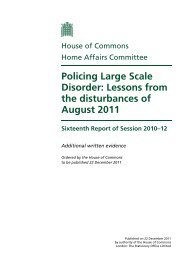Murder and Serious Sexual Assault - Lancaster EPrints - Lancaster ...
Murder and Serious Sexual Assault - Lancaster EPrints - Lancaster ...
Murder and Serious Sexual Assault - Lancaster EPrints - Lancaster ...
Create successful ePaper yourself
Turn your PDF publications into a flip-book with our unique Google optimized e-Paper software.
SUMMARY AND CONCLUSIONS<br />
previously had a conviction for burglary (which, of course, sounds quite a high<br />
figure) unless it is known how the figure compares with similar persons who have<br />
not murdered. The emphasis for this study was therefore a comparison with currently<br />
active criminals.<br />
Main findings<br />
The results of the case-control approach have been presented in terms of relative<br />
risk. Where high relative risk scores (above one) have been generated, they indicate<br />
a greater likelihood of an event taking place if the risk factor is present. Low relative<br />
risk scores (below one) indicate a lesser likelihood of the event taking place.<br />
Following convention, these factors have been identified as significant when they<br />
have been found to be statistically significant at the five per cent level. The vast<br />
majority of the discussion has focused on ‘risk factors’ – those crimes that indicate a<br />
greater likelihood of subsequent conviction for murder <strong>and</strong> SSA.<br />
The major difference between offences which provide an increased relative risk of<br />
being convicted of murder or SSA <strong>and</strong> those which provide a decreased relative risk<br />
score is that for the former, around a half of the risk factors are ‘rare’ or ‘unusual’<br />
offences, while the latter almost always fall within offence categories designated as<br />
‘frequent’ or ‘sizeable’. What the analysis highlights is that the characteristics of the<br />
general criminal population (who tend to thieve, commit burglary, shoplift, h<strong>and</strong>le<br />
stolen goods, steal vehicles, thieve from vehicles <strong>and</strong> get involved in drugs offences)<br />
tend to lower the relative risk of getting involved in murder <strong>and</strong> SSA. However, we<br />
have to be very careful in interpreting this point. Elsewhere (Soothill <strong>and</strong> Francis,<br />
1999; Soothill, Francis, S<strong>and</strong>erson <strong>and</strong> Ackerley, 2000) it has been found that a<br />
high proportion of those convicted of sex offences are engaged in other kinds of<br />
criminal activity. So, for example, while for the most prevalent offence – ‘other<br />
theft’ – shows a significantly decreased risk of subsequent SSA convictions, it needs<br />
to be remembered that almost exactly one-half (49.6%) of the SSA offenders still<br />
had this offence in their prior criminal history. The finding does not suggest that<br />
these offenders do not commit serious offences – they do. What it reveals however is<br />
that, among the general criminal population, the more routine, high volume criminal<br />
activity is not a good source for predicting future serious criminal activity.<br />
In contrast, there are some comparatively unusual offences which, from the evidence<br />
presented here, are better predictors of future convictions for murder or SSA (or<br />
both). ‘Unusual’ offences were defined as those occurring in less than two per cent of<br />
those convicted of murder or SSA. Therefore these particular offence characteristics<br />
40
















